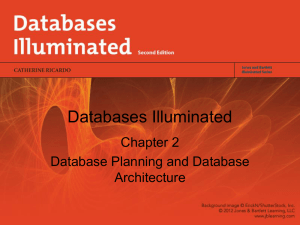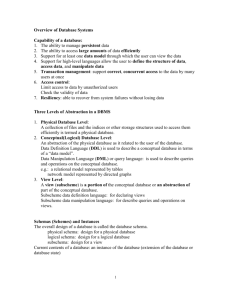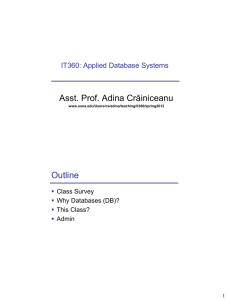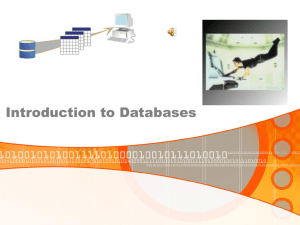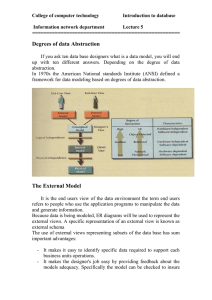database definition
advertisement
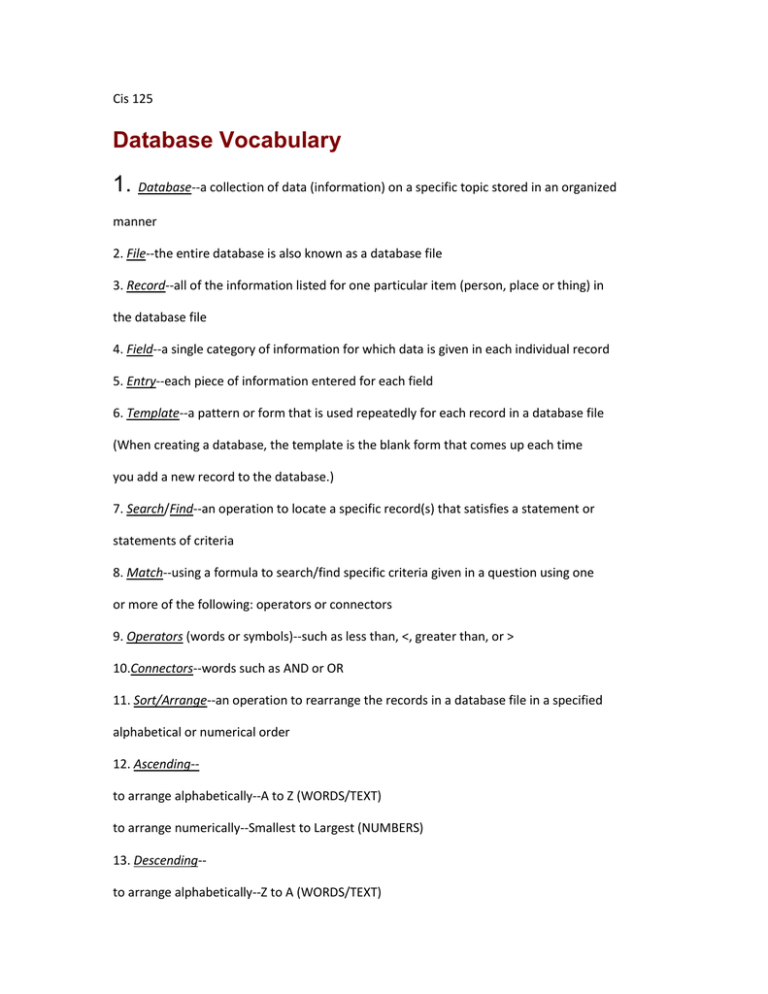
Cis 125 Database Vocabulary 1. Database--a collection of data (information) on a specific topic stored in an organized manner 2. File--the entire database is also known as a database file 3. Record--all of the information listed for one particular item (person, place or thing) in the database file 4. Field--a single category of information for which data is given in each individual record 5. Entry--each piece of information entered for each field 6. Template--a pattern or form that is used repeatedly for each record in a database file (When creating a database, the template is the blank form that comes up each time you add a new record to the database.) 7. Search/Find--an operation to locate a specific record(s) that satisfies a statement or statements of criteria 8. Match--using a formula to search/find specific criteria given in a question using one or more of the following: operators or connectors 9. Operators (words or symbols)--such as less than, <, greater than, or > 10.Connectors--words such as AND or OR 11. Sort/Arrange--an operation to rearrange the records in a database file in a specified alphabetical or numerical order 12. Ascending-to arrange alphabetically--A to Z (WORDS/TEXT) to arrange numerically--Smallest to Largest (NUMBERS) 13. Descending-to arrange alphabetically--Z to A (WORDS/TEXT) to arrange numerically--Largest to Smallest (NUMBERS) 1-database system: It is basically just a computerized record-keeping system 2- end user: Who interact with the system from online workstation or terminal . an end user can access the DB via one of the online application which is built in and not user-written application these built in applications called query language processor by which user is able to issue highlevel commands or statement to the DBMS.SQL is typical example. 3-E/R diagram: E/entities-R/relationship Is representation method to represent and entities that are in the DB and ship between them using shapes. 4-DBMS: Is the software that handles all access to the database 5-External level: Is the one closest to the users and it concerned with the way the data is viewed by individual users. 6-The conceptual level : (Known as community logical level or logical level) is a level of indirection between the other two (external & internal) 7-The internal level: (Known as physical level) is the one closest to physical storage. i.e.is the one concerned with the way the data is seen by individual user 8-Mapping : Corresponding two adjacent levels , One conceptual internal mapping: defines the correspondence between the conceptual view and the stored database . And several external conceptual mapping: defines the correspondence between a particular external view and the conceptual view. 9-DBA: DBA is the person who provides the necessary technical support for implementing the DA decision . The DBA is responsible for the overall control of the system at technical level . 10- Internal schema : Internal schema not only defines the various stored record types but also specifies what indexes exist how stored fields are represented what physical sequence the stored records are in The internal schema is written using another data definition language (The internal DDL). (1)-What are the advantages of using the database system ? 1-Redundancy can be reduced 2-Inconsistency can be avoided 3-The data can be shared 4-Standard can be enforced 5-Integrity can be maintained 6-Conflicting requirements can be balanced (2)-What are the responsibilities of DBA? 1-Definition the conceptual schema 2-Definition the internal scheme 3-Liaising write user 4-Definition security and integrity rules 5-Definition backup and recovery procedures 6-Monitoring performance and responding to change requirements (3)-Discuss the capabilities of provided by DBMS? 1-DATA DEFINITION : The DBMS must be able to accept data definition in source from and convert them to appropriate object from 2-DATA MANIPULATION: The DBMS must be able to handle requests to retrieve update or delete existing data in the database or to odd new data to database 3- OPTIMIZATION AND EXECUTION: DML (data manipulation language) requests planned or unplanned must be processed by the optimizer component whose purpose is to determine an efficient way of implementing the request 4-DATA SECURITY AND INTEGRITY: The DBMS must monitor user request and reject any attempts to violate the security and integrity constraints defined by the DBA 5-DATA RECOVERY AND CONCURRENCY: The DBMS or more likely some other related software component usually called the transaction manager or transaction processing monitor (TP monitor) must enforce certain recovery and concurrency controls 6-PERFORMANCE: It goes without saying that the DBMS should perform all of the tasks identified above as efficient possible (4)-COMBARE BETWEEN THE DA AND THE DBA? The data administrator DA is person who make the strategic and policy decision regarding the data of the enterprise and the DBA is the person who provides the necessary technical support for implementing those decision thus DBA responsible for the overall control of the system at technical level (5)-What are the mapping ?mention two levels of mapping in the ANSI/SPARC database model why do we need mappings in that model? Mapping is: Correspondence between two adjacent levels , Two levels of mapping one from the conceptual level to the internal level and one from the external level to the conceptual level The conceptual internal mapping : Defines the correspondence between the conceptual view and the stored database it specifies how conceptual view and the stored database the conceptual internal mapping is the key to physical data independence the external conceptual mapping are the key to logical data independence (6)-discuss the four components of database system? DB system involves four major components: DATA:DB system is available on machine that range from quite small micros (pc) to the large main frame System in large machine tends to multi user whereas those on smaller machine tend to be single user A single user system is a system in which at most one user can access the DB at any given time A multi user system is a system in which many users can access DB concurrently The data in DB will both integrated and shared: By integration we mean that the DB can be thought of several distinct data files with any redundancy among those files at least partly eliminated By sharing we mean that individual pieces of data in the DB can be shared among several different users To in the sense that each of those users can have access to the same piece of data soft ware: Between the physical DB and the user of the system is a layer of software the DB management system All requests from user access to the DB are handled by the DBMS The facilities of all operations are provided by DBMS On general function provided is that DBMS is shielding of DB users from H/W level details Hard ware: Hardware portion of the system consists of: The second storage volume that are used to hold the stored data together with the associated I/O device controllers and so forth The processor and it associated main memory that are used to support the execution of the database system software Users : Three broad classes of users : 1-application programmers : who are responsible for writing application programs that use the DB the programs may be conventional batch applications or may be on line applications 2-end users : who litrat with the system from on line work station or terminals an end user can access DB via on line application which is built in and not user written applications The built in applications called query language processor simply query languages by which user is able to issue high level command or statements to the DBMS SQL is typical example 3-DB administrator :DBA who administrate and mange the sharing resources which is itself and DBMS soft ware DBA is responsible for authorizing access to the DB for coordinating and monitoring its use and for acquiring soft ware and hard ware resources as needed (7)-what are utilities ? Utilities are programs designed to help the DBA with various administration tasks as mentioned in the previous section some utility programs operate at the external level of the system and thus are effectively nothing more than special purpose application some might not even be provided by the DBMS vendor but rather by some third party other utilities however operate directly at the internal level and hence must be provided by the DBMS vender (8)-what do we mean by the term relational system ?distinguish between the relational and non relational systems? A relational database is basically just a database in which the data is perceived as tables and of course it is true than a good question relation is just a mathematical term for a table to be precise a table of a certain specific kind relational systems are based on the relational model the relational model in turn is an abstract theory of data that is based on certain aspects of mathematics mainly ser theory and predicate logically (9)-differentiate between persistent input and output data Persistent data: Any data that is transient in nature Output data : Refers to the message and results outputting from the system such information might be derived from the persistent data but not part of DB Input data: Refers to the information entering the system at the first time such information might cause changes to make to persistent data but not part of DB (10)-what is client/server model? Database system can be regard as having every simple two parts structure consists of a server and set of client Keys: 1-Primary key :primary key is a unique identifier a column or column combination with the property that no two rows at the table contain the same value in that column or column combination All table should have at least one primary key No two records of the table contain the same identifier Any two tuples cannot share the same key 2-forign key: it is an attribute or set of attributes within one relation that matches the candidate key of some (possibly the same )relation It is important & responsible for linking the tables together Not necessary all tables have foreign key 3-candidate key : a candidate key for relation R is subset K of the attributes of R such that: a- No two distinct tuples of R have the same value for K (uniqueness property ) b- No proper subset of K has the uniqueness property (irreducibility) c- Candidate key might be primary key we choose for example three candidate key & choose one or two to be primary key d- Candidate key can be primary e- Candidate key can be combined more than one Define : 1-DATABASE SYSTEM : Is a computerized record –keeping system 2-END USER: Who access the database interactively as just described an end can access the database via one of the on applications and he can use an interface provided as an integral part of the system 3-E/R DIAGRAM =(E/entitles R/relationship Diagram ) Entitle: Is used in database circles to mean any distinguishable object that is to be represented in the database Relationships : Linking those basic entitles together they are just as much a part of data as are the basic entitles 4-DBMS The database management system is the software that handles all access to the database 5-EXTERNAL LEVEL (user logical level )is the one closest to the one concerned with the way the data is seen by individual users 6-CONCEPTUAL LEVEL (community logical level) is a level of indirection between the other two level (internal and external) 7-INTERNAL LEVEL (storage level) :is the one closest to the physical storage it is the one concerned with the way the data is inside the system 8-MAPPING Translation from level to level Mappings define the correspondence between (a)-a given external schema and the internal schema and (b)the conceptual schema and the internal schema Those mappings are the key to the provision of logical and physical data independence 9-DBA Is the person who provides the necessary technical support for implementing strategic and policy designs DBA is responsible for the overall control of the system at technical level 10-INTERNAL SCHEMA It defines the various stored record types and specifies what index exist how stored fields are represent what language the internal DDL The hardware processor(s) and associated main memory that are used to support the execution database system software 4-USERS Three broad classes of users: 1-application programmers who are responsible for writing DB application programs in some programming languages 2-who access the database interactively as just described an end can access the database via one of the on-line applications and he can use an interface provided as an integral part of the system 3-DB administrator DBA is the person who provides the necessary technical support for implementing strategic and policy designs DBA is responsible for the overall control of the system at technical level 7- what are utilities in data base? Utilities are programs designed to help the DBA with various administration tasks some examples of the kind of utilities : 1-load routines 2-unload/reload routines 3-reorganization routines 4-statistical routines 5-analysis routines 8-what do we mean by the term relational system? distinguish between the relational and non relational system ? a relational system is a system in which the data is perceived by the user as table (and nothing but tables ) the operators available to the user for (e. g.)retrieval are operators that drive new tables from old ones it is just a mathematical term for a table the distinguish between relational and non relational systems: a relational system the user sees the data as tables and nothing but tables in a non relational system the user sees other data structures (either instead of or as well as the tables of a relational system )those other structures in turn require other operators to access them 9-differentiate between persistent input and output data? Persistent data Data differ in nature from any other transient data In/out data Refers to the information entering the system for the first time such information might cause changes to made to the persistent data but it is not part of the DB

